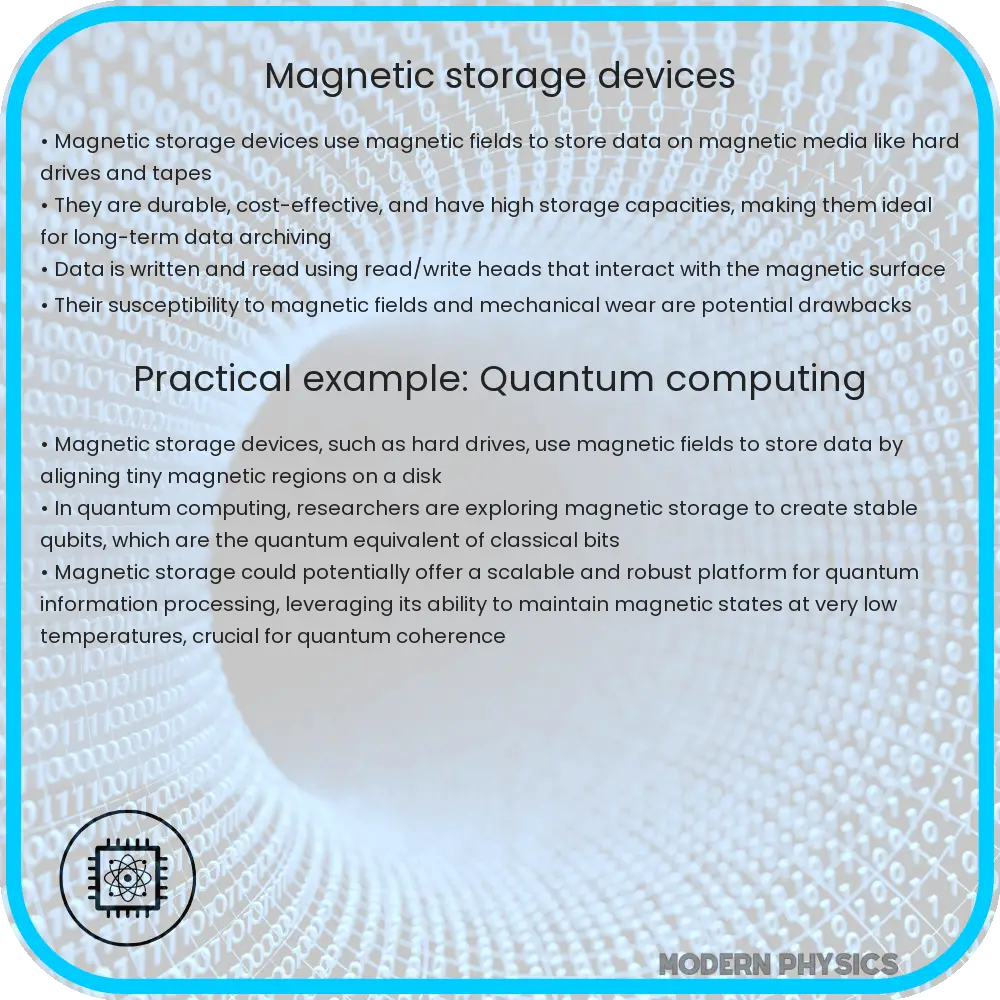Learn how magnetic storage devices like HDDs and magnetic tapes store and retrieve data through magnetization, their durability factors, and advances in storage capacity.

Understanding Magnetic Storage Devices
Magnetic storage devices have been at the core of data storage for decades. These devices, which include hard disk drives (HDDs) and magnetic tapes, store data by manipulating the magnetic properties of a material. As technology has evolved, so too has the capacity and durability of these devices, making them crucial even in an age dominated by solid-state drives (SSDs).
How Magnetic Storage Works
The principle behind magnetic storage is relatively straightforward. A magnetic storage device records data by magnetizing tiny segments of a metal platter or tape in different directions. A reading head in the device then detects and interprets these magnetized areas as data. This is made possible because each magnetized segment generates a small magnetic field, which can be detected as a binary 0 or 1, forming the data that the device stores or retrieves.
Durability of Magnetic Storage Devices
One of the key advantages of magnetic storage devices is their durability. Hard disk drives, for example, consist of a sealed metal enclosure that helps protect sensitive magnetic platters from dust, humidity, and mechanical shocks. Magnetic tapes are often used for backup storage because they can be stored in controlled environments and have a lifespan of several decades if handled properly. However, these devices are susceptible to wear and tear over time, particularly from the mechanical movement of the read/write heads and the spinning of the disk platters.
- Wear and Tear: The constant motion involved in accessing data can gradually degrade a magnetic disk.
- Environmental Factors: Though well-protected, magnetic storage can still suffer from extreme temperatures and exposure to magnetic fields.
- Technological Issues: The complexity of the moving parts within HDDs can lead to mechanical failures.
Capacity Trends in Magnetic Storage
Over the years, the storage capacity of magnetic devices has increased significantly, thanks to advancements in magnetic recording technology. One of the key developments has been the transition from longitudinal recording to perpendicular magnetic recording and, more recently, to shingled magnetic recording. Each of these technologies allows for greater data density, effectively increasing storage capacity without needing to increase the physical size of the disk.
- Perpendicular Magnetic Recording (PMR): Aligns the magnetic bits vertically rather than horizontally, enabling tighter data packing.
- Shingled Magnetic Recording (SMR): Overlaps data tracks like shingles on a roof to increase density further, although this can complicate data rewriting.
These innovations have allowed HDDs to maintain relevance in an industry increasingly opting for faster, albeit more expensive, SSDs. Integrating these newer recording technologies, manufacturers have managed to produce large-capacity drives suited for both consumer and enterprise data storage needs.
Comparison with Solid-State Drives (SSDs)
While magnetic storage devices continue to evolve, they face stiff competition from solid-state drives (SSDs). SSDs use flash memory to store data, offering faster access times and lower latency compared to HDDs. This makes SSDs particularly advantageous in environments where speed and efficiency are crucial. However, magnetic storage devices offer benefits that SSDs cannot match:
- Cost-effectiveness: Per GB, magnetic storage is often cheaper than SSDs, making it a more viable option for bulk or archival storage.
- Longevity: SSDs have a limited number of write cycles, whereas HDDs can often handle more data writing and rewriting over their lifespan.
Therefore, while SSDs are preferred for their speed, HDDs remain indispensable for cost-effective large-volume storage and long-term archival purposes.
Future Prospects of Magnetic Storage
Despite the advances in SSD technology, the future of magnetic storage appears secure. Innovations such as Heat-Assisted Magnetic Recording (HAMR) and Two-Dimensional Magnetic Recording (TDMR) promise to push the boundaries of magnetic storage capacity even further. These technologies aim to increase areal density, allowing for even larger storage capacities in the same physical space.
- Heat-Assisted Magnetic Recording (HAMR): Uses localized heating to allow for smaller magnetic bits and closer bit spacing, enabling higher data density.
- Two-Dimensional Magnetic Recording (TDMR): Enhances read/write capabilities by using multiple read/write heads that operate together, improving data accuracy and storage density.
Research and development in these areas suggest that magnetic storage will continue to play a crucial role in data storage architectures, particularly for applications requiring durability and affordability.
Conclusion
Magnetic storage devices, such as HDDs and magnetic tapes, have evolved significantly over the years, maintaining their relevance in the data storage industry despite the rise of SSDs. The durability, cost-effectiveness, and increasing storage capacities of magnetic devices ensure they remain valuable for various applications, especially where large-volume storage and data longevity are priorities. Future technologies like HAMR and TDMR will further enhance the capabilities of magnetic storage, securing its place in the data storage hierarchy for years to come. By understanding the mechanics, advancements, and comparative benefits of magnetic storage, users and enterprises can make informed decisions about their storage solutions, balancing speed, cost, and capacity according to their specific needs.
